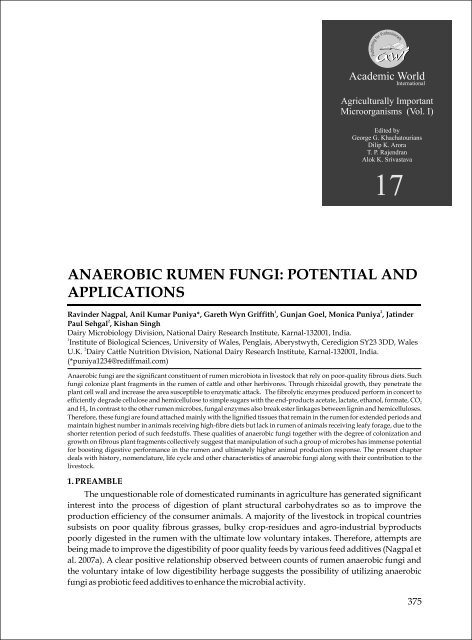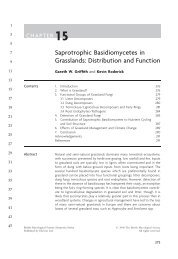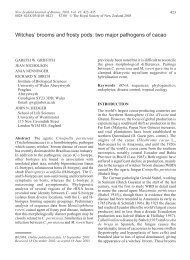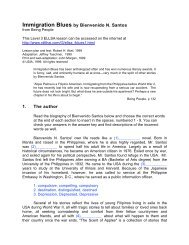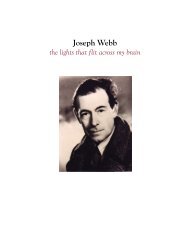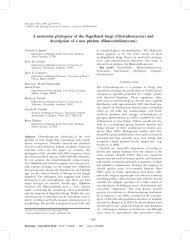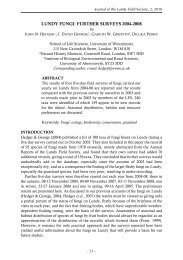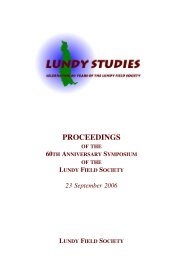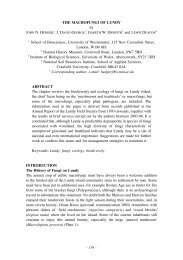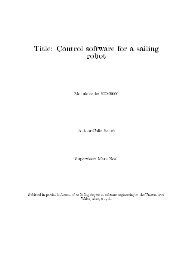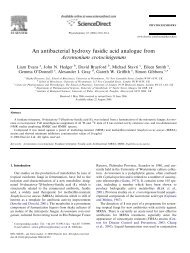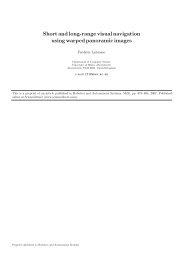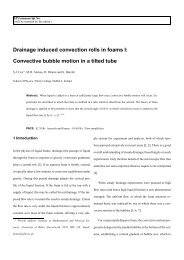Anaerobic rumen fungi
Anaerobic rumen fungi
Anaerobic rumen fungi
Create successful ePaper yourself
Turn your PDF publications into a flip-book with our unique Google optimized e-Paper software.
ANAEROBIC RUMEN FUNGI: POTENTIAL AND<br />
APPLICATIONS<br />
1 2<br />
Ravinder Nagpal, Anil Kumar Puniya*, Gareth Wyn Griffith , Gunjan Goel, Monica Puniya , Jatinder<br />
2<br />
Paul Sehgal , Kishan Singh<br />
Dairy Microbiology Division, National Dairy Research Institute, Karnal-132001, India.<br />
1<br />
Institute of Biological Sciences, University of Wales, Penglais, Aberystwyth, Ceredigion SY23 3DD, Wales<br />
2<br />
U.K. Dairy Cattle Nutrition Division, National Dairy Research Institute, Karnal-132001, India.<br />
(*puniya1234@rediffmail.com)<br />
<strong>Anaerobic</strong> <strong>fungi</strong> are the significant constituent of <strong>rumen</strong> microbiota in livestock that rely on poor-quality fibrous diets. Such<br />
<strong>fungi</strong> colonize plant fragments in the <strong>rumen</strong> of cattle and other herbivores. Through rhizoidal growth, they penetrate the<br />
plant cell wall and increase the area susceptible to enzymatic attack. The fibrolytic enzymes produced perform in concert to<br />
efficiently degrade cellulose and hemicellulose to simple sugars with the end-products acetate, lactate, ethanol, formate, CO 2<br />
and H 2.<br />
In contrast to the other <strong>rumen</strong> microbes, fungal enzymes also break ester linkages between lignin and hemicelluloses.<br />
Therefore, these <strong>fungi</strong> are found attached mainly with the lignified tissues that remain in the <strong>rumen</strong> for extended periods and<br />
maintain highest number in animals receiving high-fibre diets but lack in <strong>rumen</strong> of animals receiving leafy forage, due to the<br />
shorter retention period of such feedstuffs. These qualities of anaerobic <strong>fungi</strong> together with the degree of colonization and<br />
growth on fibrous plant fragments collectively suggest that manipulation of such a group of microbes has immense potential<br />
for boosting digestive performance in the <strong>rumen</strong> and ultimately higher animal production response. The present chapter<br />
deals with history, nomenclature, life cycle and other characteristics of anaerobic <strong>fungi</strong> along with their contribution to the<br />
livestock.<br />
1. PREAMBLE<br />
r<br />
o<br />
f<br />
g<br />
n<br />
i<br />
h<br />
s<br />
i<br />
l<br />
b<br />
u<br />
P<br />
P<br />
r<br />
fe s<br />
o s<br />
Academic World<br />
Agriculturally Important<br />
Microorganisms (Vol. I)<br />
Edited by<br />
George G. Khachatourians<br />
Dilip K. Arora<br />
T. P. Rajendran<br />
Alok K. Srivastava<br />
i<br />
o<br />
n<br />
a<br />
ls<br />
17<br />
International<br />
The unquestionable role of domesticated ruminants in agriculture has generated significant<br />
interest into the process of digestion of plant structural carbohydrates so as to improve the<br />
production efficiency of the consumer animals. A majority of the livestock in tropical countries<br />
subsists on poor quality fibrous grasses, bulky crop-residues and agro-industrial byproducts<br />
poorly digested in the <strong>rumen</strong> with the ultimate low voluntary intakes. Therefore, attempts are<br />
being made to improve the digestibility of poor quality feeds by various feed additives (Nagpal et<br />
al. 2007a). A clear positive relationship observed between counts of <strong>rumen</strong> anaerobic <strong>fungi</strong> and<br />
the voluntary intake of low digestibility herbage suggests the possibility of utilizing anaerobic<br />
<strong>fungi</strong> as probiotic feed additives to enhance the microbial activity.<br />
375
Agriculturally Important Microorganisms Vol. II<br />
Rumen anaerobic <strong>fungi</strong> actively colonize plant cell walls and account for up to 8-12% of the<br />
microbial biomass in <strong>rumen</strong> (Rezaeian et al. 2004). Prior to their discovery, it was assumed that<br />
only <strong>rumen</strong> anaerobic bacteria and protozoa were involved in hydrolysis of plant biomass. But<br />
now, it is well established that these ruminal <strong>fungi</strong> effectively take part in fibre digestion in<br />
ruminants (Dey et al. 2004, Lee et al. 2004). The rhizoids of their vegetative thalli penetrate deep<br />
into plant tissues better than bacteria and protozoa, and thus achieve access to plant materials<br />
otherwise unavailable to other <strong>rumen</strong> microorganisms. This infiltration leads to a more rapid<br />
degradation of forage entering the <strong>rumen</strong> (Orpin and Joblin, 1988; Nagpal et al. 2007b). These<br />
<strong>fungi</strong> secrete high levels of very active fibre-degrading enzymes (cellulases, hemicellulases,<br />
xylanases, avicelases, glycosidases etc.) found to be associated with rhizomycelia (Williams et al.<br />
1994; Lee et al. 2001).<br />
2. HISTORICAL MILIEU<br />
The ruminal anaerobic <strong>fungi</strong>, reported as early as 1910, were thought to be flagellate protozoa<br />
(Liebetanz, 1910; Braune, 1913) and placed in the genera Callimastix, Sphaeromonas and Oikomonas.<br />
These flagellates were recognized as <strong>fungi</strong> for the first time in the 1970s (Orpin, 1975) with the first<br />
named species Neocallimastix frontalis. The flagellate zoospores encyst and germinate on ingested<br />
forage with radiating rhizoids that produce a single zoosporangium. In terms of lifecycle and<br />
morphology, N. frontalis is similar to members of Chytridiomycota and its fungal affinities are<br />
confirmed by chitin in the cell wall (Orpin, 1975); though uniquely among the <strong>fungi</strong> it is an<br />
obligate anaerobe. About twenty different species of anaerobic <strong>rumen</strong> <strong>fungi</strong> have been reported<br />
in various ruminant and hindgut-fermenting mammals. It is established that removal of these<br />
<strong>fungi</strong> from the <strong>rumen</strong> results in a significant diminution in in-vitro gas production and<br />
degradation of fibrous feeds, signifying a vital role such <strong>fungi</strong> play in fibre degradation (Lee et al.<br />
2004). The enzyme profiles of various <strong>fungi</strong> studied indicated secretion of a wide range of lignocellulolytic<br />
enzymes. Scanning electron microscopic studies ascertained that these <strong>fungi</strong><br />
preferably attach to most lignified tissues of plant feed (Akin, 1987). Hence, fibre-based diets<br />
stimulate their proliferation in the <strong>rumen</strong> compared to diets rich in easily fermentable<br />
carbohydrates (Paul et al. 2003). Pelleted diets generally have a shorter transit time through the<br />
gastro-intestinal tract and therefore do not support good anaerobic growth of <strong>rumen</strong> <strong>fungi</strong> in-situ.<br />
High soluble sugar content inhibits germination of fungal zoospores on plant tissues (Roger et al.<br />
1992), and this might be due to lowered pH of <strong>rumen</strong> liquor (Orpin, 1977).<br />
3. TAXONOMIC STATUS<br />
<strong>Anaerobic</strong> zoospore-producing <strong>fungi</strong> are very recently assigned to Chytridiomycota, a basal<br />
group within kingdom Fungi and subdivided into five orders i.e., Blastocladiales,<br />
Monoblepharidiales, Chytridales, Spizellomycetales and Neocallimastigales (Barr, 1990). Based<br />
on the ultrastructural characteristics of zoospores, anaerobic <strong>fungi</strong> were originally placed in the<br />
order Spizellomycetales (Barr, 1980; Barr and Desaulniers, 1988) but later transferred to a separate<br />
order (Neocallimastigales) by Li et al (1993). The precise relatedness of the Neocallimastigales to<br />
other chytrid <strong>fungi</strong> is at present unclear since they possess a number of features not common with<br />
other chytrid taxa (hydrogenosomes, polyflagellate zoospores, distinctive flagellar attachment;<br />
Barr, 1990; James et al., 2000), and are distinctive in other respects too (e.g. very high AT [ca. 70%]<br />
DNA base ratio; Brownlee, 1989). The recent international collaborative effort (AFTOL project: All<br />
Fungus Tree Of Life; http://aftol.org/) to establish a multiple gene genealogy for kingdom Fungi<br />
found Chytridiomycota to be polyphyletic (with loss of flagellate zoospores on several occasions)<br />
but confirmed anaerobic <strong>fungi</strong> basal to the 'core' chytrid clade (James et al., 2006a; b). On the basis<br />
376
ANAEROBIC RUMEN FUNGI<br />
of many distinctive features of anaerobic <strong>fungi</strong> relative to other chytrids, these may be assigned to<br />
a new phylum Neocallimastigomycota phylum nov. (MycoBank no.: MB 501279), containing a single<br />
class Neocallimastigomycetes nov. (MycoBank no.: MB 501280) (Hibbett et al., 2007).<br />
Gold et al (1988) recommended subdivision of anaerobic <strong>fungi</strong> into three genera<br />
Neocallimastix, Piromyces (formerly Piromonas) and Caecomyces (formerly Sphaeromonas).<br />
However, three other genera with more complex growth morphology have subsequently been<br />
discovered i.e. Orpinomyces (Barr et al. 1989), Anaeromyces (Breton et al. 1990) and Cyllamyces<br />
(Ozkose et al. 2001). In all such genera, multiple sporangia are formed in Orpinomyces and<br />
Anaeromyces on a more extensive polycentric thallus. Cyllamyces, like Caecomyces, forms bulbous<br />
holdfasts (which can cause rupture of plant tissues; Joblin, 1989) rather than a rhizoidal system<br />
with up to 12 sporangia formed on branched sporangiophores. Thus, the six genera can be<br />
divided into three groups based on colony morphology (monocentric, polycentric or bulbous).<br />
However, it is likely that zoospore flagellation represents a more fundamental division within the<br />
anaerobic <strong>fungi</strong> with Neocallimastix and Orpinomyces having multiflagellate (5-20 flagella)<br />
zoospores while other genera being uniflagellate. Table 1 represents the classification and<br />
different morphological characteristics of ruminal anaerobic <strong>fungi</strong>.<br />
Kingdom:<br />
Phylum:<br />
Class:<br />
Order:<br />
Genera:<br />
Table 1. Classification and morphological characteristics of anaerobic<br />
<strong>fungi</strong> (after Barr, 1990; James et al., 2000; Hibbett et al., 2007).<br />
A.<br />
B.<br />
Fungi<br />
Neocallimastigomycota<br />
Neocallimastigomycetes<br />
Neocallimastigales<br />
Monocentric: Neocallimastix: zoospore with 4 - 20 flagella;<br />
thallus with filamentous branching rhizoids; Piromyces:<br />
zoospore with 1 - 4 flagella and thallus with filamentous<br />
branching rhizoids, and<br />
Polycentric: Orpinomyces: multiflagellate zoospores;<br />
Anaeromyces: zoospore with single flagellum; Cyllamyces:<br />
zoospore with 1 - 2 flagella with thalloid branched<br />
sporangiophore.<br />
Bulbous: Caecomyces: zoospores with 1 - 2 flagella; thallus with<br />
globular rhizoid; Cyllamyces: zoospore with 1 - 2 flagella,<br />
thalloid branched sporangiophores<br />
Presently, 18 species of anaerobic <strong>fungi</strong> have been identified and described (Table 2). No<br />
anaerobic <strong>fungi</strong> have hitherto, been reported to have a sexual stage.<br />
4. THE LIFE CYCLE<br />
The life cycle of monocentric <strong>fungi</strong> is asexual and shifts between a motile, zoosporic and a<br />
vegetative, zoosporangial stage (Figure 1). The flagellate zoospores move by chemotaxis to<br />
colonize the fibre material (Orpin and Bountiff, 1978; Munn et al. 1988). N. patriciarum zoospores<br />
show chemotaxis towards several carbohydrates as receptors e.g. glucose, mannose, sorbitol and<br />
sucrose (Orpin and Bountiff, 1978), and move across the plant surface, presumably to stumble on<br />
the right location for encystment. After release, these get encysted and germinate exogenously to<br />
form a germ tube from which the rhizoids emerge (Orpin, 1977). The cell mass develops into a<br />
377
Agriculturally Important Microorganisms Vol. II<br />
378<br />
Table 2. Classification of anaerobic <strong>fungi</strong> (after Cabe, 1998; Ozkose et al. 2001; Harhangi, 2002).<br />
Genus/ Species Source(s) Reference(s)<br />
Caecomyces:<br />
C. communis; C. equi<br />
Piromyces:<br />
P. communis ; P. mae; P.<br />
dumbonica ; P. rhizinflata; P.<br />
minutus; P. spiralis; P. citronii<br />
Neocallimastix:<br />
N. frontalis ; N. patriciarum ;<br />
N. hrleyensis; N. variabilis<br />
Anaeromyces:<br />
A. elegans; A. mucronatus<br />
Orpinomyces:<br />
O. joyonii; O. intercalaris<br />
Sheep; Horse<br />
Sheep; cow;<br />
Horse; Elephant;<br />
Deer; Goat;<br />
Donkey<br />
Sheep; Cow<br />
Cow; Sheep<br />
Sheep; Cow<br />
Gold et al. (1988)<br />
Gold et al. (1988); Julliand et al.<br />
(1998); Li et al. (1990); Breton et al.<br />
(1991); Ho et al. (1993a & b);<br />
Gaillard-Martinie et al. (1995)<br />
Heath et al. (1983); Orpin and<br />
Munn, (1986); Webb and<br />
Theodorou, (1991); Ho et al.<br />
(1993c)<br />
Ho et al. (1993d); Breton et al.<br />
(1990)<br />
Breton et al. (1989); Ho et al.<br />
(1994)<br />
Cyllamyces:<br />
C. aberensis Cow Ozkose et al. (2001)<br />
sporangium and cytokinesis results in uninucleate zoospores to be released to complete the cycle.<br />
From studies on Neocallimastix, it is established that the life cycle lasts about 23-32 hours (Lowe et<br />
al. 1987a), whilst in Cyllamyces aberensis, it is slightly shorter to 18-24 hrs (Ozkose et al. 2001).<br />
Zoospores development from young sporangia may occur within 8 hours after encystment under<br />
appropriate conditions (Orpin, 1977).<br />
Unlike monocentric and bulbous taxa, polycentric <strong>fungi</strong> have less determinate lifecycles and can<br />
differentiate multiple sporangia over periods of several days. Nuclei are visible within rhizoids<br />
but it is unclear to what extent these resemble hyphae of higher <strong>fungi</strong> (Ho and Bauchop, 1991).<br />
Zoosporogenesis is asynchronous as in other taxa and in culture, zoospores are often very rare<br />
(Phillips, 1989 Fliegerova et al., 2004).<br />
Fig.1. Life cycle of anaerobic <strong>fungi</strong> (Source: Teunissen and Op den Camp, 1993; Harhangi, 2002).
5. DISTRIBUTION IN NATURE<br />
<strong>Anaerobic</strong> <strong>fungi</strong> have been reported in all geographic regions of the world, being ubiquitous<br />
among fore-gut fermenters and ruminants such as cattle, buffalo, goat (Ho et al. 1993a; 1993c;<br />
Singhal, 2000; Thareja et al. 2006), red deer, impala (Bauchop, 1979) and wild Bluebull (Boselaphus<br />
tragocamelus) (Paul et al. 2004; Tripathi et al. 2007a) as well as marsupials including kangaroo,<br />
wallaroo and swamp wallaby (Breton et al. 1989). These <strong>fungi</strong> have also been isolated from faecal<br />
samples of the horse, zebra, donkey, rhinoceros and Indian elephant (Bauchop, 1983; Breton et al.<br />
1990; Li et al. 1990; Orpin, 1994; Theodorou et al. 1994), all being hindgut fermenters. Therefore,<br />
these <strong>fungi</strong> appear to be a standard constituent of the gut microflora in many herbivores fed on a<br />
highly fibrous diet.<br />
6. METABOLISM AND PHYSIOLOGY<br />
<strong>Anaerobic</strong> <strong>fungi</strong> derive energy by anaerobic fermentation of carbohydrates (Trinci et al. 1994). A<br />
large number of poly-, oligo-, and monosaccharides including glucose, cellobiose, fructose,<br />
maltose, sucrose and xylose, support their growth (Orpin, 1975, 1976; Mountfort and Asher, 1983;<br />
Phillips and Gordon, 1988). <strong>Anaerobic</strong> <strong>fungi</strong> follow a mixed-acid fermentation profile similar to<br />
enterobacteria such as E. coli with the conversion of hexose to acetate, formate, lactate, succinate,<br />
ethanol, CO 2 and H 2 (Borneman et al. 1989, Trinci et al. 1994). These products may fluctuate among<br />
different genera i.e. high malate and lactate by Anaeromyces spp. compared to Orpinomyces<br />
(Phillips and Gordon, 1988). Table 3 shows the outline of cellulose fermentation by N. frontalis:<br />
Table 3. Fermentation of cellulose by N. frontalis (Bauchop and Mountfort, 1981).<br />
Fermentation product mol/ 100 mol hexose<br />
Acetate<br />
72.7<br />
Lactate<br />
67.0<br />
Ethanol<br />
37.4<br />
Formate<br />
83.1<br />
Carbon dioxide<br />
37.6<br />
Hydrogen<br />
35.3<br />
Methane 0.0<br />
ANAEROBIC RUMEN FUNGI<br />
<strong>Anaerobic</strong> <strong>fungi</strong> lack mitochondria, cytochromes and other biochemical features of the<br />
oxidative phosphorylation pathway. In cytosol, all major enzymes required for glycolysis<br />
through the Embden-Meyerhof-Parnas pathway are present while glucose-6-phosphate<br />
dehydrogenase and the other enzymes of Entner-Dodouroff pathway are absent (Yarlett et al.<br />
1986; O'Fallon et al. 1991; Marvin-Sikkema et al. 1993). The group possesses organelles<br />
(hydrogenosomes) for a major part of anaerobic energy metabolism (Muller, 1993; Trinci et al.<br />
1994; Benchimol et al. 1996). Hydrogenosomes are spherical double-membrane bound redox<br />
organelles (0.2 – 1 µm), and have been reported in phylogenetically distant amitochondriate<br />
eukaryotes that inhabit anaerobic or microaerophilic environments (Muller, 1993).<br />
7. TRANSFER AND SURVIVAL BETWEEN DIFFERENT HOSTS<br />
<strong>Anaerobic</strong> <strong>fungi</strong> can be isolated from alimentary tracts of ruminants (Davies et al. 1990, 1993)<br />
and propagules survive in air-dried faeces up to 10 months (Milne et al. 1989; Theodorou et al.<br />
1990; McGranaghan et al. 1999). There have been attempts to identify putative aero-tolerant<br />
resting structures (Wubah et al., 1991b; Nielsen et al., 1995; Richardson et al., 1998), though only in<br />
a single unnamed Anaeromyces species have spores been unequivocally identified (Ozkose, 2001;<br />
379
Agriculturally Important Microorganisms Vol. II<br />
Brookman et al., 2000b). In the latter case, <strong>fungi</strong> could be resuscitated from pure cultures after<br />
incubation at 39ºC for up to 11 months (anaerobic <strong>fungi</strong>, however, do not survive beyond 10 days<br />
without subculturing) (Ozkose, 2001). Furthermore, thick-walled, elongate and septate spores<br />
are readily visible in these cultures. The ability of anaerobic <strong>fungi</strong> to form spores and possibly,<br />
other resting structures in large part explain why they can be transferred so readily between host<br />
animals, and far more easily than <strong>rumen</strong> protozoans which require direct animal contact<br />
(Williams, 1986). In fact, during an early study on <strong>rumen</strong> protozoans, Becker and Hsiung (1929)<br />
prevented re-infection by "Callimastix" [sic] of isolated defaunated goats for more than a few<br />
weeks (even if the feed was sterilized). As is the case with <strong>rumen</strong> protozoans, transfer of<br />
anaerobic <strong>fungi</strong> from mother to neonates can also occur by direct contact with saliva during<br />
grooming and licking, or by coprophagy (Lowe et al. 1987b; Milne et al. 1989). In sheep, anaerobic<br />
fungal populations are established by 8-10 days of birth (Fonty et al. 1987). As ruminal <strong>fungi</strong> can<br />
utilize lactose as a carbon and energy source, their population, along with other microorganisms,<br />
gets accumulated and develops in the under developed <strong>rumen</strong> of young lambs fed on milk; and<br />
subsequently stabilizes with the development of <strong>rumen</strong> as the animal starts consuming fibrous<br />
diet (Fonty et al. 1987; Fonty and Grenet, 1994).<br />
Fungal transfer in nature is not only inter-ruminant, but also from non-ruminant to ruminant<br />
as these can also be transmitted by aerosols and dried faeces (Orpin, 1989; Dehority and Orpin,<br />
1996). Interspecies transfer has been demonstrated by the establishment in sheep of high ruminal<br />
populations of Piromyces sp. isolated from horse faeces and also a strain of Neocallimastix from the<br />
reindeer <strong>rumen</strong> (Orpin, 1989). Orpinomyces sp. and Piromyces sp., from cow's <strong>rumen</strong> and faeces of<br />
wild blue bull, respectively, establish in the <strong>rumen</strong> after administrating to male buffalo calves fed<br />
with wheat straw based diets (Tripathi et al. 2007b). As with the <strong>rumen</strong> protozoans, where<br />
evidence of host specificity is equivocal (Williams, 1986), the various anaerobic fungal taxa show<br />
little geographic structure with diet having a far greater effect on fungal population than the host.<br />
However, Phillips and Gordon (1988) reported that polycentric taxa could not be isolated from<br />
sheep in Australia.<br />
8. FIBRE DEGRADATION POTENTIAL<br />
The role of <strong>rumen</strong> <strong>fungi</strong> in the degradation of plant fibre has been examined extensively<br />
(Theodorou et al. 1989; Samanta et al. 2001; Paul et al. 2004; Dey et al. 2004; Lee et al. 2004; Thareja<br />
et al. 2006; Dayanand et al. 2007; Tripathi et al. 2007a, b). The rhizoids or bulbous holdfasts of<br />
vegetative thalli are better at penetrating plant tissue than are bacteria and protozoa, so they gain<br />
access to the plant material not accessible to other <strong>rumen</strong> microorganisms (Orpin and Joblin,<br />
1988). Bauchop and Mountfort (1981) suggested that such penetrations lead to a faster and<br />
complete degradation of forage entering the <strong>rumen</strong>. Degradation of lignified plant cell walls is an<br />
important characteristic of <strong>rumen</strong> <strong>fungi</strong> (Mountfort et al. 1982; Akin and Benner, 1988). Zoospores<br />
of many species colonize the lignified tissues preferentially and establish colonies localized on<br />
sclerenchyma and xylem cells. Early observations indicated that lignified cell walls were<br />
degraded to a greater extent by <strong>rumen</strong> <strong>fungi</strong> than by <strong>rumen</strong> bacteria and protozoa. Experiments<br />
14<br />
with specifically labeled C polysaccharides or lignin indicated that the <strong>rumen</strong> <strong>fungi</strong> solubilize<br />
phenolics and degrade lignocellulose, although cannot consume the lignin moiety (Gordon and<br />
Phillips, 1989).<br />
<strong>Anaerobic</strong> <strong>fungi</strong> penetrate the cuticle, the rigid structural barrier on the outside of the plant<br />
epidermis. These <strong>fungi</strong> often enter the leaf interior through stomata in the epidermal layer (Akin<br />
et al. 1983) giving these <strong>fungi</strong> an advantage in degrading plant fibre through substantial increase<br />
380
ANAEROBIC RUMEN FUNGI<br />
in the area available for infection. Rumen <strong>fungi</strong> also show protease activity that may have role in<br />
degradation, because the plant structural proteins increase the integrity of plant cell wall (Wallace<br />
and Joblin, 1985). Species of Piromyces, Neocallimastix, Orpinomyces and Anaeromyces degrade fibre<br />
to a substantial degree. Caecomyces species degrade fibres but lesser than other genera (Gordon,<br />
1990), perhaps because of the lack of an extensive rhizoidal system. In Bermuda grass (Cynodon<br />
dactylon), stems and leaves harbour Neocallimastix and Orpinomyces species to degrade the plant<br />
material most effectively by weakening the textural strength of the residue (Akin et al. 1990).<br />
These findings suggest that the ability to degrade fibre varies among fungal genera, and that<br />
plants differ in their support for fungal growth. The greater ability of <strong>rumen</strong> <strong>fungi</strong>, compared to<br />
<strong>rumen</strong> bacteria, to weaken forage fibres may be vital to enhancing its utilization by the host<br />
animal (Borneman and Akin, 1990).<br />
Ito et al. (1994) studied sheep <strong>rumen</strong> <strong>fungi</strong> for degradability and digestibility of rice straw<br />
and observed significant decrease in lignin residue that in turn increased digestibility of the feed.<br />
Studies by Manikumar et al. (2002) and Dey et al. (2004) indicated increased in vitro dry matter<br />
digestibility, and decreased cell wall contents of straws by different anaerobic <strong>fungi</strong> viz,<br />
Orpinomyces, Piromyces and Anaeromyces relative to untreated controls. Also, the molar yield of<br />
acetate increased with simultaneous decrease for propionate and butyrate. In a subsequent<br />
report, hydrolysis of rice and wheat straw by Orpinomyces sp. (C14) was superior to that of<br />
Piromyces or Anaeromyces (Manikumar et al. 2003).<br />
Gordon and Phillips (1998) reported a 7-12% increase in voluntary intake of straw based diet<br />
by sheep dosed with monocentric <strong>fungi</strong> from other herbivores. In contrast, no such effect on feed<br />
intake was observed in crossbred calves dosed with polycentric Orpinomyces sp. However, the<br />
growth rate and nutrient digestion in cow calves improved in the fungus-administered sets.<br />
There was also a two and a half fold increase in the fungal count in <strong>rumen</strong> liquor of fungusadministered<br />
animals (Dey et al. 2004).<br />
Lee et al. (2000, 2004) studied the effect of administration of Orpinomyces strain KNGF2 from<br />
Korean native goats, or their enzymes on the extent of ruminal fermentation, microbial<br />
population, enzyme activities and nutrient digestion in sheep <strong>rumen</strong>. There was a 2-3 fold<br />
increase in cellulolytic bacterial count in case of anaerobic fungal treatment of silage based ratios<br />
compared to the control.<br />
9. FIBROLYTIC ENZYMES<br />
The ability of ruminants in digesting the plant structural polysaccharides, primarily cellulose<br />
and hemicelluloses, depends on the capacity of microorganisms inhabiting <strong>rumen</strong>, and <strong>rumen</strong><br />
<strong>fungi</strong> play a major role in degradation of lignified plant tissues (Akin and Benner, 1988). For plant<br />
cell wall degradation, such anaerobic <strong>fungi</strong> produce a wide range of hydrolytic enzymes,<br />
cellulases (Barichievich and Calza, 1990; Yanke et al. 1993), hemicellulases (Mountfort and Asher,<br />
1989), proteases (Michel et al. 1993), amylases, amyloglycosidases (Paul et al. 2004), feruloyl and<br />
p-coumaryl esterases (Borneman et al. 1992), various disaccharidases (Chen et al. 1994),<br />
pectinases (Gordon and Phillips, 1992) and exonucleases (Cabe, 1998).<br />
Three enzymes viz, endo-1,4--glucanase, exo-1,4--glucanase and -glucosidase act<br />
synergistically for efficient cellulose hydrolysis. These enzymes often bind to the substrate prior<br />
to hydrolysis, but they may also bind to other plant cell wall polymers such as xylan (Gilkes et al.<br />
1991). Aryl esterases, viz. p-coumaroyl esterases and feruloyl esterases are other important<br />
enzymes that hydrolyze the ester linkages between hemicellulose and lignin in plant cell walls,<br />
381
Agriculturally Important Microorganisms Vol. II<br />
and thus separating hemicelluloses and cellulose from lignin (Borneman and Akin, 1990) and<br />
render them accessible to hemicellulases and cellulases. Thus, through esterases, anaerobic <strong>fungi</strong><br />
play a more important role over bacteria in separating the lignin-polysaccharide linkages in the<br />
plant particles by extensive rhizoidal elongation, and are thus ahead of bacteria. N. patriciarum<br />
solubilized lignin (up to 34%) in sorghum (McSweeney et al. 1994). Unlike <strong>rumen</strong> cellulolytic<br />
bacteria, <strong>rumen</strong> <strong>fungi</strong> also have proteases that facilitate penetration of the plant proteinaceous<br />
components by fungal rhizoids (Engels and Brice, 1985).<br />
Most fibrolytic enzymes have been found associated with rhizomycelium while some<br />
secreted into the surroundings (Gordon and Phillips, 1992; Williams et al. 1994). The activities of<br />
these enzymes are common to both the zoosporic and vegetative stages as well as in the cell-free<br />
spent culture fluid (Williams and Orpin, 1987); but depend on the stage of the life cycle (Martin<br />
and Nisbet, 1992; Lee et al. 2001). A few fibrolytic enzymes are constitutive, and regulated by the<br />
presence of soluble sugars (Mountfort and Asher, 1983, 1985, 1989), e.g. production of cellulase<br />
repressed by glucose (Mountfort and Asher, 1985). Growth conditions greatly influence enzyme<br />
production as the level of fibrolytic enzymes was 3-fold in a stirred fermenter compared to static<br />
batch cultures (Morgavi et al. 1994; Paul et al. 2003).<br />
Because of the ability of cellulases to rapidly attack crystalline cellulose, there has been<br />
considerable interest in the fibre degrading enzymes of anaerobic <strong>fungi</strong> (Teunissen et al. 1993).<br />
Wilson and Wood (1992) reported that isolates of Neocallimastix and Piromyces were the most<br />
rapid degraders of crystalline cellulose. The weakening of tissues by fungal enzymes may<br />
accelerate digestion, and thus making rumination more effective in reducing particle size and<br />
increasing protozoal and bacterial digestion in the <strong>rumen</strong>.<br />
10. MICROECOLOGY IN THE RUMEN<br />
The interactions of anaerobic <strong>fungi</strong> with other <strong>rumen</strong> microbes can be positive, negative or<br />
neutral, depending on the microbial group involved and the type of substrate used. Since, <strong>rumen</strong><br />
<strong>fungi</strong> produce appreciable amounts of H 2; they can interact with H 2 utilizers which in turn alter<br />
their metabolite production. Methanogens are the principal H 2 utilizers in <strong>rumen</strong>; and stable<br />
cocultures of <strong>fungi</strong> and methanogens have been established in vitro (Fonty and Joblin, 1991; Orpin<br />
and Joblin, 1997). Such cocultures resulted in increased fungal biomass (Bernalier et al. 1989) and<br />
also an increase in the rate and extent of cellulose degradation (Wood et al. 1986; Joblin et al. 1989;<br />
Bernalier et al. 1991). Interspecies H 2 transfer between the cellulolytic H2-producing anaerobic<br />
<strong>fungi</strong> and methanogens resulted in increased CO 2 and acetate formation but decreased ethanol<br />
and lactate output (Bauchop and Mountfort, 1981; Mountfort et al. 1982). The presence of<br />
Methanobacterium arboriphilus, Methanobacterium bryantii, or Methanobrevibacter smithii also<br />
increased (5 to 10%) the level of cellulose fermentation by anaerobic <strong>fungi</strong> (Marvin-Sikkema et al.<br />
1990). By contrast, cellulose degradation and lactate production by N. frontalis decreased in<br />
cocultures with non-lactate utilizing Selenomonas ruminantium, the sugar fermenting, H 2<br />
consuming <strong>rumen</strong> bacterium, thus indicating interspecies hydrogen transfer (Richardson and<br />
Stewart, 1990).<br />
The <strong>fungi</strong> are involved in cross-feeding in that they release free sugars, which in addition to<br />
several of their normal metabolites (except acetate), serve as energy sources for other bacterial<br />
species. The <strong>fungi</strong> themselves may also depend on the bacteria for supply of B vitamins, heme and<br />
amino acids, as the nutritional requirement (Williams et al. 1994). On the other hand, coculture of<br />
anaerobic <strong>fungi</strong> with <strong>rumen</strong> bacteria inhibits the cellulolytic activity (Bernalier et al. 1992; Roger et<br />
382
ANAEROBIC RUMEN FUNGI<br />
al. 1993) and growth (Dehority and Tirabasso, 2000) of the former. Stewart et al. (1992) and<br />
Bernalier et al. (1993) reported an extracellular, thermo-labile protein produced by ruminococci,<br />
which inhibits fungal cellulase activity. Dehority and Tirabasso (1993) also reported that mixed<br />
<strong>rumen</strong> bacteria produce a heat stable compound in vitro, which markedly inhibits growth of<br />
<strong>rumen</strong> <strong>fungi</strong>.<br />
Since chitin is the main structural component of fungal cell wall, their growth is likely to be<br />
inhibited by <strong>rumen</strong> chitinolytic microorganisms such as Clostridium sp. Co-culturing of the<br />
anaerobic <strong>fungi</strong> with chitinolytic Clostridium tertium significantly reduced solubilization of<br />
crystalline cellulose, production of short-chain fatty acids and release of endoglucanase<br />
(Hodrova et al. 1995), suggesting the role of chitinolytic bacteria in controlling fungal activities in<br />
vivo. Thus, <strong>rumen</strong> <strong>fungi</strong> do not appear to attain their optimal fibre-degrading potential in <strong>rumen</strong><br />
due to the inhibition by some bacteria. Small sized fungal zoospores are likely to be a prey for<br />
protozoa. Co-incubation of protozoa with <strong>fungi</strong> revealed that protozoa are able to ingest and<br />
digest <strong>fungi</strong> (Morgavi et al. 1994). The fungal growth and cellulolysis is negatively affected by<br />
<strong>rumen</strong> protozoa, possibly because of protozoal predation on zoospores.<br />
11. RESPONSE TO DIVERSE DIETS<br />
The forage rich diets such as hay and silage, with a long ruminal transit time, consistently<br />
result in high population density of anaerobic <strong>fungi</strong> (Fonty and Grenet, 1994). The addition of<br />
maize to sorghum silage enhanced degradation by anaerobic <strong>fungi</strong> (Akin and Windham, 1989).<br />
Also, the addition of grain concentrate to the hay diet significantly increased the count of fungal<br />
zoospores in sheep <strong>rumen</strong> (Faichney et al. 1997). In sheep consuming appreciable amounts of<br />
fibres, a large number of sporangia are found attached to stem fragments before morning feeding<br />
(Bauchop, 1979). Fungal populations were also stimulated to a much greater extent with alfalfa<br />
diet than with coastal Bermuda grass (Windham and Akin, 1984).<br />
By contrast, diet rich in soluble carbohydrates (i.e. young pasture, whey and fodder beet)<br />
result in a relatively low population density of anaerobic <strong>fungi</strong> (Grenet et al. 1989). Silage diet<br />
from sorghum or maize reduced the numbers of anaerobic <strong>fungi</strong> in the <strong>rumen</strong> (Akin et al. 1988).<br />
Similarly, rye grass at the leafy stage, was also found unfavorable for <strong>fungi</strong> (Grenet et al. 1989).<br />
<strong>Anaerobic</strong> <strong>fungi</strong> are generally adversely affected by the addition of lipid to the diet (Jenkins,<br />
1993). Feeding a supplement of sunflower, cottonseed or rapeseed oil meal to animals also<br />
depressed fungal population in the <strong>rumen</strong> (Elliott et al. 1987; Fonty and Grenet, 1994).<br />
12. CONTRIBUTION OF FUNGI TO HOST NUTRITION<br />
Various reports suggest a positive correlation between anaerobic <strong>fungi</strong> and voluntary intake<br />
of low digestible herbage diet (Akin et al. 1983; Weston et al. 1988; Gordon and Phillips, 1993). This<br />
association is an outcome of fungal attack on lignified tissues (Akin, 1987; Akin and Borneman,<br />
1990) combined with the weakening of more recalcitrant plant components (Akin et al. 1983,<br />
1989). Soft feed fragments in the <strong>rumen</strong> may be anticipated to lead to less effort by the animal in<br />
eating and ruminating. A positive correlation between populations of <strong>rumen</strong> anaerobic <strong>fungi</strong> and<br />
rumination efficiency in sheep fed a wheat straw diet has been reported by Weston et al. (1988).<br />
Therefore, anaerobic <strong>fungi</strong> apparently facilitate the physical disruption during rumination of the<br />
fibrous particles of poor-quality feed leading to a lower residence of such particles in the <strong>rumen</strong>.<br />
The intake of forage by early weaned calves was 35% higher in calves dosed with Neocallimastix<br />
sp. (Theodorou et al. 1990), and the dosing of fungus-free sheep with Neocallimastix sp. resulted in<br />
a 40% increased intake of a straw-based diet (Gordon and Phillips, 1993).<br />
383
Agriculturally Important Microorganisms Vol. II<br />
These <strong>fungi</strong> also supply protein to the host through the action of proteolytic enzymes and<br />
also as a proportion of the microbial protein synthesized in the <strong>rumen</strong> that passes to abomasum<br />
and intestines for digestion and absorption (Gordon and Phillips, 1998). Kemp et al. (1985), Gulati<br />
et al. (1989) and Onoda et al. (1993) reported that fungal cells are composed of proteins with a well-<br />
balanced combination of amino acids which were highly accessible to and digestible by the<br />
ruminant; and a high proportion of fungal protein is digested and absorbed in the intestines of<br />
sheep with higher digestibility compared to ruminal bacteria (Gulati et al. 1990). Moreover, the<br />
advent of dependable measurements of fungal biomass in ruminant digesta has shown that in<br />
sheep fed with either hay or grain diets, anaerobic <strong>fungi</strong> averaged 2.4% of the microbial nitrogen<br />
in ruminant digesta (Faichney et al. 1997). However, the contribution of anaerobic <strong>fungi</strong> towards<br />
supply of microbial proteins to the animal was minor as these averaged 1.6% of the microbial<br />
nitrogen in digesta flowing to duodenum. Yet, this microbial protein was of high quality and<br />
voluntarily available to animal. Therefore, if the biomass of anaerobic <strong>fungi</strong> in the <strong>rumen</strong> is<br />
enhanced, it is likely that the supply of high-quality microbial protein to host ruminant would be<br />
possible (Gordon and Phillips, 1998).<br />
13. ISOLATION, CHARACTERIZATION AND PERSISTENCE<br />
To culture the <strong>rumen</strong> anaerobic <strong>fungi</strong>, one of the methods involves overlaying the partially<br />
molten agar with filtered <strong>rumen</strong> fluid and incubation at 39°C (48 hrs) as by this time, zoospores<br />
settle and produce individual thalli to yield pure cultures (Orpin, 1975). Lowe et al. (1985)<br />
suggested a plate culture technique to isolate <strong>rumen</strong> <strong>fungi</strong> from <strong>rumen</strong> digesta of sheep and cattle.<br />
The roll-bottle method of Joblin (1981) involves inoculating a dilution series of molten agar<br />
medium with filtered <strong>rumen</strong> fluid. After a period of incubation, axenic cultures could be obtained<br />
from the individual colonies produced. Antibiotics penicillin, streptomycin, neomycin and<br />
chloramphenicol can be added to the isolation media to suppress bacterial growth (Wubah et al.<br />
1991a). It is difficult to maintain these <strong>fungi</strong> as they require an oxygen-free atmosphere. Hence,<br />
the cultures are to be maintained under CO atmosphere during growth.<br />
2<br />
The paucity of morphological features presents a problem regarding the taxonomy of<br />
anaerobic <strong>fungi</strong>. While examining plant material from the digestive tract, <strong>fungi</strong> often appear as<br />
the complex cluster and this makes the classification even up to genus level difficult. At a time<br />
when there is little disagreement as to the status of the six genera, subgeneric classification is<br />
problematic since difficulties associated with exchange and long-term maintenance of cultures<br />
impeded direct morphological and physiological comparisons among isolates. With the advent of<br />
molecular taxonomy, it is hoped that DNA sequence comparisons and phylogenetic<br />
reconstruction will elucidate the relatedness of the various taxa. Indeed, a number of molecular<br />
phylogenetic papers are on record (Brookman et al. 2000a; Fliegerova et al. 2004; Tuckwell et al.<br />
2 0 0 5 ) , a n d o v e r 1 0 0 n u c l e o t i d e s e q u e n c e s d e p o s i t e d w i t h G e n e b a n k<br />
(http://www.ncbi.nlm.nih.gov).<br />
Majority of the sequences deposited relate to the ribosomal RNA genes widely used in<br />
phylogenetic reconstruction. The small ribosomal (18S) subunit is highly conserved in different<br />
taxa and thus contains little phylogenetically useful information for subgeneric classification (Li<br />
and Heath, 1992). In contrast, the internal transcribed spacer (ITS) regions, widely used for study<br />
of closely related fungal taxa, show a high level of variability (Li and Heath, 1992; Brookman et al.<br />
2000a; Fliegerova et al. 2004), and has been used to differentiate the morphologically similar<br />
monocentric (Neocallimastix, Piromyces) and polycentric (Anaeromyces, Orpinomyces) genera.<br />
Brookman et al. (2000a) also reported that the two multiflagellated taxa (Neocallimastix,<br />
384
ANAEROBIC RUMEN FUNGI<br />
Orpinomyces) were closely related based on the ultrastructure of the zoospores. Unfortunately,<br />
various problems including the presence of divergent ITS sequences within individual isolates<br />
has hampered widespread use of this locus for taxonomic studies (Ozkose, 2001), though PCR<br />
amplification of DNA from environmental samples (<strong>rumen</strong> fluid, digesta etc.) using ITS primers<br />
may prove valuable for ecological studies (Tuckwell et al. 2005).<br />
Counts of individual zoospores and zoosporangia have been used to estimate fungal<br />
populations in vitro (Joblin, 1981) and in vivo (Ushida et al. 1989). Breton et al. (1991) used colonyforming<br />
units per gram dry weight of faeces as the basis for quantifying species of Piromyces. An<br />
endpoint dilution practice, based on the technique of most probable numbers, was developed to<br />
enumerate <strong>rumen</strong> <strong>fungi</strong> as thallus-forming units (Theodorou et al. 1990). The procedure involves<br />
a 10-fold dilution series of sample in an antibiotic-containing basal anaerobic medium. Defined<br />
medium plus 10% clarified <strong>rumen</strong> fluid was used for dilution series, and fungal population<br />
represented as thallus-forming units per gram of dry weight.<br />
An indirect method based on zoospore concentration and life cycle parameters has been used<br />
to quantify <strong>fungi</strong> in the <strong>rumen</strong>. Exploiting the life history parameters and growth kinetics of these<br />
<strong>fungi</strong>, France et al. (1990) proposed a mathematical model of the life cycle in a steady state so that<br />
the population of the particle-attached fungal thalli could be calculated from the concentration of<br />
free-swimming zoospores in <strong>rumen</strong> fluid. The values obtained were reliable for samples from<br />
<strong>rumen</strong> and faeces. However, the inadequate knowledge of the life cycle of anaerobic <strong>fungi</strong> makes<br />
it complicated to evaluate the consistency of this technique.<br />
For long-term maintenance of these <strong>fungi</strong>, cultures are usually stored in liquid nitrogen using<br />
anaerobic glycerol as the cryoprotectant. Pure cultures of anaerobic <strong>fungi</strong> can also be maintained<br />
in a defined medium consisting of cell-free <strong>rumen</strong> fluid, tryptone, yeast extract, a carbon source,<br />
buffer, L-cysteine as the reducing agent, and vitamins (Wubah et al. 1991a). Neocallimastix frontalis<br />
has been maintained in a similar medium but without the yeast extract and <strong>rumen</strong> fluid (Lowe et<br />
al. 1985). For prolonged maintenance in the laboratory, pure cultures of anaerobic <strong>fungi</strong> are<br />
transferred into fresh basal anaerobic medium every 3-4 days. Joblin (1981), however, reported<br />
that cultures could be maintained for several months on plant tissues stored at 39°C without subculturing.<br />
Yarlett et al. (1986) reported cryopreservation of the anaerobic fungus Neocallimastix<br />
patriciarum at -80°C with dimethyl sulphoxide as the cryoprotectant, but the survival rate was<br />
only 40% after one year. However, in a similar study by Sakurada et al. (1995), the survival<br />
reached 80% after one year of storage at -84°C with ethylene glycol and cell-free <strong>rumen</strong> fluid.<br />
14. FUTURE PROSPECTS<br />
Rumen microbiologists have constantly shown curiosity in manipulation of the <strong>rumen</strong><br />
microbial ecosystem to boost feedstuff utilization and improved milk production. It is now a wellestablished<br />
fact that anaerobic <strong>fungi</strong> participate in hydrolysis of plant biomass in ruminants,<br />
based on superior penetration of plant tissues over bacteria or protozoa, and thus leading to an<br />
enhanced degradation of forage in the <strong>rumen</strong>. These <strong>fungi</strong> are well equipped with enzymes<br />
important for <strong>rumen</strong> fermentation, and represent group of dynamic cellulolytic organisms that<br />
explicitly colonize fibrous plant fragments. The properties taken together with perceptible extent<br />
of <strong>rumen</strong> populations in animals on high-fibre diets indicates a significant role of such<br />
heterotrophs in fibre digestion. In addition, <strong>fungi</strong> may bring special changes to plant materials in<br />
the <strong>rumen</strong> with the resultant improved feed intake, body weight gain, enhanced milk output, and<br />
improved animal productivity. As efforts are still in its early stages regarding stimulation of<br />
<strong>rumen</strong> fermentation by anaerobic <strong>fungi</strong>, more studies are imperative to assess the extent of their<br />
385
Agriculturally Important Microorganisms Vol. II<br />
contribution to the ruminal digestive event. However, the development of direct-fed microbials<br />
for improved <strong>rumen</strong> performance is a pre-requisite for sustainable animal production. Therefore,<br />
a substantial potential exists for the manipulation of fungal population and activity in the <strong>rumen</strong><br />
to benefit even from poor quality herbages.<br />
CONCLUSION<br />
In the lack of efficient feed materials, utilization of high fibrous crop-residues and<br />
agricultural by-products along with the tested animal probiotic could be a better alternative over<br />
the existing feeding practices. With the onset of technology for production and administration of<br />
direct-fed microbials, it seems feasible to effectively utilize the poor quality fibrous feeds for<br />
higher productivity of animals. Since, there is considerable disparity among the fungal isolates<br />
from domestic as well as wild animals in their fibre degrading potential; there is immense scope to<br />
isolate efficient fibrolytic fungal strains with elevated levels of fibrolytic enzymes so that they can<br />
be posted in the <strong>rumen</strong> for optimum feed utilization. Therefore, more work is needed to study the<br />
diversity of these <strong>fungi</strong> among domestic and wild ruminants, and to isolate/ select the elite<br />
strains with high fibrolytic activity which can get established in the <strong>rumen</strong> to facilitate digestion of<br />
low grade roughages for enhanced meat/ milk production, as the case may be.<br />
ACKNOWLEDGEMENTS : The authors, especially AKP and GWG wish to thank Indian National Science<br />
Academy, New Delhi and Royal Society, London for supporting the establishment of long-term relations between<br />
Indian and UK counterpart, by providing financial assistance to the former for a short visit to UK under scientists<br />
exchange programme.<br />
REFERENCES<br />
Akin DE (1987). Association of <strong>rumen</strong> <strong>fungi</strong> with various forage grasses. Anim Feed Sci Tech 16: 273-385.<br />
Akin DE and Benner R (1988). Degradation of polysaccharides and lignin by ruminal bacteria and <strong>fungi</strong>. Appl<br />
Environ Microbiol 54: 1117-1125.<br />
Akin DE and Borneman WS (1990). Role of <strong>rumen</strong> <strong>fungi</strong> in fibre degradation. J Dairy Sci 73: 3023-3032.<br />
Akin DE and Windham WR (1989). Influence of diet on <strong>rumen</strong> <strong>fungi</strong>. In: Nolan JA, Leng RA and Demeyer DL (eds).<br />
The roles of protozoa and <strong>fungi</strong> ruminant digestion. Australia: Armidale, pp 75-81.<br />
Akin DE, Borneman WS and Windham WR (1988). Rumen <strong>fungi</strong>: morphological types from Georgia cattle and the<br />
attack on forage cell walls. Biosystems 21: 385-391.<br />
Akin DE, Gordon GLR and Hogan JP (1983). Rumen bacterial and fungal degradation of Digitaria pentzii grown with<br />
or without sulphur. Appl Environ Microbiol 46: 738-748.<br />
Akin DE, Lyon CE, Windham WR and Rigsby LL (1989). Physical degradation of lignified stem tissues by ruminal<br />
<strong>fungi</strong>. Appl Environ Microbiol 55: 611-616.<br />
Akin DE, Rigsby LL, Lyon CE and Windham WR (1990). Relationship of tissue digestion to textural strength in<br />
Bermuda grass and alfalfa stems. Crop Sci 30: 990-993.<br />
Barichievich EM and Calza RE (1990). Supernatant protein and cellulase activities of the anaerobic ruminal fungus<br />
Neocallimastix frontalis EB188. Appl Environ Microbiol 56: 43-48.<br />
Barr DJS (1980). An outline for the reclassification of the Chytridiomycetales, and for a new order, the<br />
Spizellomycetales. Can J Bot 58: 2380-2394.<br />
Barr DJS (1990). Phylum Chytridiomycota. In: Margulis L, Corliss JO, Melkonian M, Chapman DJ. (eds). Handbook of<br />
Protoctista. Boston: Jones & Bartlett, pp 454–466.<br />
Barr DJS and Desaulniers NL (1988). Precise configuration of organisms of the chytrid zoospore. Can J Bot 66: 869-876.<br />
Barr DJS, Kudo H, Jakober KD and Cheng KJ (1989). Morphology and development of <strong>rumen</strong> <strong>fungi</strong>: Neocallimastix sp,<br />
Piromyces communis, and Orpinomyces bovis gen. nov, sp. nov. Can J Bot 67: 2815-2824.<br />
Bauchop T (1979). Rumen anaerobic <strong>fungi</strong> of sheep and cattle. Appl Environ Microbiol 38: 148-158.<br />
Bauchop T (1983). The gut anaerobic <strong>fungi</strong>: colonizers of dietary fibre. In: Wallace G and Bell L (eds). Fibre in human<br />
and animal nutrition. Wellington: Royal Society of New Zealand, pp 143-148.<br />
386
ANAEROBIC RUMEN FUNGI<br />
Bauchop T and Mountfort DO (1981). Cellulose fermentation by a <strong>rumen</strong> anaerobic fungus in both the absence and<br />
presence of <strong>rumen</strong> methanogens. Appl Environ Microbiol 42: 1103-1110.<br />
Becker ER and Hsiung TS (1929). The method by which ruminants acquire their fauna of infusoria, and remarks<br />
concerning experiments on the host specificity of these protozoa. Proc Natl Acad Sci (USA) 15: 684-690.<br />
Benchimol M, Johnson PJ and De Souza W (1996). Morphogenesis of the hydrogenosome: an ultrastructural study.<br />
Biol Cell 87: 197-205.<br />
Bernalier A, Bogaert C, Fonty G and Jouany JP (1989). Effect of ionophore antibiotics on <strong>rumen</strong> anaerobic <strong>fungi</strong>. In:<br />
Nolan JV, Leng RA and Demeyer DI (eds). The roles of protozoa and <strong>fungi</strong> in ruminant digestion. Australia:<br />
Armidale, Penambul Books, pp 273-275.<br />
Bernalier A, Fonty G and Gouet P (1991). Cellulose degradation by two <strong>rumen</strong> anaerobic <strong>fungi</strong> in monoculture or in<br />
coculture with <strong>rumen</strong> bacteria. Anim Feed Sci Tech 32: 131-136.<br />
Bernalier A, Fonty G, Bonnemoy F and Gouet P (1992). Degradation and fermentation of cellulose by the <strong>rumen</strong><br />
anaerobic <strong>fungi</strong> in axenic cultures or in association with cellulolytic bacteria. Curr Microbiol 25: 143-148.<br />
Bernalier A, Fonty G, Bonnemoy F and Gouet P (1993). Inhibition of the cellulolytic activity of Neocallimastix frontalis<br />
by Ruminococcus flavefaciens. J Gen Microbiol 139: 873-880.<br />
Borneman WS and Akin DE (1990). Lignocellulose degradation by <strong>rumen</strong> <strong>fungi</strong> and bacteria: Ultrastructure and cell<br />
wall degrading enzymes. In: Akin DE, Ljungdahl LG, Wilson JR and Harris PJ (eds). Microbial and Plant<br />
Opportunities to Improve Lignocellulose Utilization by Ruminants. New York: Elsevier, pp 325-339.<br />
Borneman WS, Akin DE and Ljungdahl LG (1989). Fermentation products and plant cell wall degrading enzymes<br />
produced by monocentric and polycentric anaerobic <strong>rumen</strong> <strong>fungi</strong>. Appl Environ Microbiol 55: 1066-1073.<br />
Borneman WS, Ljungdahl LG, Hartley RD and Akin DE (1992). Purification and partial characterization of two<br />
feruloyl esterases from the anaerobic fungus Neocallimastix strain MC2. Appl Environ Microbiol 58: 3762-3766.<br />
Braune R (1913). Untersuchungen uber die in Weider Kavermayen Vorkommenden Protozoen. Arch Protistenk 32:<br />
111-170.<br />
Breton A, Bernalier A, Bonnemoy F, Fonty G, Gaillard B and Gouet P (1989). Morphological and metabolic<br />
characterization of a new species of strictly anaerobic <strong>rumen</strong> fungus : Neocallimastix joyonii. FEMS Microbiol<br />
Lett 58: 309-314.<br />
Breton A, Bernalier A, Dusser M, Fonty G, Gaillard-Martinie B and Guillot J (1990). Anaeromyces mucronatus nov. gen,<br />
nov. sp. A new strictly anaerobic <strong>rumen</strong> fungus with polycentric thallus. FEMS Microbiol Lett 70: 177-182.<br />
Breton A, Dusser M, Gaillard-Martinie B, Guillot J, Millet L and Prensier G (1991). Piromyces rhizinflata nov. sp, a<br />
strictly anaerobic fungus from the faeces of the Saharan ass: a morphological, metabolic and ultrastructural<br />
study. FEMS Microbiol Lett 66:1-8.<br />
Brookman JL, Mennim G, Trinci APJ, Theodorou MK and Tuckwell DS (2000a). Identification and characterization of<br />
anaerobic gut <strong>fungi</strong> using molecular methodologies based on ribosomal ITS1 and 18S rRNA. Microbiol 146: 393-<br />
403.<br />
Brookman JL, Ozkose E, Rogers S, Trinci APJ and Theodorou MK (2000b). Identification of spores in the polycentric<br />
anaerobic gut <strong>fungi</strong> which enhance their ability to survive. FEMS Microbiol Ecol 31:261-267.<br />
Brownlee AG (1989). Remarkably AT-rich genomic DNA from the anaerobic fungus Neocallimastix. Nucleic Acids<br />
Res 17:1327-1335.<br />
Cabe TKM (1998). Production of cellulolytic enzymes using immobilized anaerobic <strong>fungi</strong>. PhD dissertation.<br />
University of Western Sydney, Macarthur, Australia.<br />
Chen H, Li X and Ljungdhal LG (1994). Isolation and properties of an extracellular â-glucosidase from the polycentric<br />
<strong>rumen</strong> fungus Orpinomyces sp. strain PC-2. Appl Environ Microbiol 60: 64-70.<br />
Davies DR, Theodorou MK and Trinci APJ (1990). <strong>Anaerobic</strong> <strong>fungi</strong> in the digestive tract and faeces of growing steers:<br />
evidence for a third stage in their life cycle. In: Reisinger A and Bresinsky A (eds). Fourth International<br />
Mycological Congress. Germany: Regensburg, pp 226.<br />
Davies DR, Theodorou MK, Lawrence MIG and Trinci APJ (1993). Distribution of anaerobic <strong>fungi</strong> in the digestive<br />
tract of cattle and their survival in faeces. J Gen Microbiol 139: 1395-1400.<br />
Dayanand TL, Nagpal R, Puniya AK, Sehgal JP and Singh K (2007). In-vitro degradation of urea-NH treated wheat<br />
3<br />
straw using anaerobic ruminal <strong>fungi</strong>. J Anim Feed Sci 16: 484-489.<br />
Dehority BA and Orpin CG (1996). Development of, and natural fluctuations in, <strong>rumen</strong> microbial populations. In:<br />
Hobson PN, Stewart CS (eds). The Rumen Microbial Ecosystem. London: Chapman and Hall, pp 196–245.<br />
387
Agriculturally Important Microorganisms Vol. II<br />
nd<br />
Dehority BA and Tirabasso PA (1993). Antibiosis between <strong>rumen</strong> bacteria and <strong>fungi</strong>. 22 Biennial Conference on<br />
Rumen Function, Chicago, IL. November 9-11, 6.<br />
Dehority BA and Tirabasso PA (2000). Antibiosis between ruminal bacteria and ruminal <strong>fungi</strong>. Appl Environ<br />
Microbiol 66: 2921-2927<br />
Dey A, Sehgal JP, Puniya AK and Singh K (2004). Influence of an anaerobic fungal culture (Orpinomyces sp.)<br />
administration on growth rate, ruminal fermentation and nutrient digestion in calves. Asian-Aus J Anim Sci 17:<br />
733-884<br />
Elliot R, Ash AJ, Calderon-Cortes F, Norton BW and Bauchop T (1987). The influence of anaerobic <strong>fungi</strong> on <strong>rumen</strong><br />
volatile fatty acid concentrations in vivo. J Agric Sci 109: 13-17.<br />
Engels FM and Brice RE (1985). A barrier covering lignified cell walls of barley straw that resist access by <strong>rumen</strong><br />
microorganisms. Curr Microbiol 12: 217-224.<br />
Faichney GJ, Poncet C, Lassalas B, Jouany JP, Millet L, Dore J and Brownlee AG (1997). Effects of concentrates in a hay<br />
diet on the contribution of anaerobic <strong>fungi</strong>, protozoa and bacteria to nitrogen in <strong>rumen</strong> and duodenal digesta in<br />
sheep. Anim Feed Sci Tech 64: 193-213.<br />
Fliegerova K, Hodrova B and Voigt K (2004). Classical and molecular approaches as a powerful tool for the<br />
characterization of <strong>rumen</strong> polycentric <strong>fungi</strong>. Folia Microbiol 49: 157-164.<br />
Fonty G and Grenet E (1994). Effects of diet on the fungal population of the digestive tract of ruminants. In: Mountfort<br />
DO and Orpin CG (eds). <strong>Anaerobic</strong> Fungi: Biology, Ecology and Function. New York: Marcel Dekker, pp 229-<br />
239.<br />
Fonty G and Joblin KN (1991). Rumen anaerobic <strong>fungi</strong>: their role and interaction in other <strong>rumen</strong> microorganisms in<br />
relation to fibre digestion. In: Tsuda T, Sasaki Y and Kawashima R (eds). Physiological aspect of digestion<br />
metabolism in ruminants. San Diego: Academic press, pp 655-680<br />
Fonty G, Gouet Ph, Jouany JP and Senand J (1987). Establishment of the microflora and anaerobic <strong>fungi</strong> in the <strong>rumen</strong><br />
of lambs. J Gen Microbiol 133: 1835-1943.<br />
France J, Theodorou MK and Davies D (1990). Use of zoospore concentration and life cycle parameters in determining<br />
the population of anaerobic <strong>fungi</strong> in the <strong>rumen</strong> ecosystem. J Theor Bio 147. 413-422.<br />
Gaillard-Martinie B, Breton A, Dusser M and Julliand V (1995). Piromyces citronii sp. nov, a strictly anaerobic fungus<br />
from the equine caecum: a morphological, metabolic and ultrastructural study. FEMS Microbiol Lett 130: 321-<br />
326.<br />
Gilkes NR, Henrissat B and Kilburn DG (1991). Domains in microbial -1,4–glucanases: sequence conservation,<br />
function and enzyme families. Microbiol Rev 55: 303-315.<br />
Gold JJ, Heath IB and Bauchop T (1988). Ultrastructural description of a new chytrid genus of caecum anaerobe,<br />
Caecomyces equi gen. nov. sp. nov, assigned to the Neocallimasticaceae. Biosystems 21.403-415.<br />
Gordon GLR (1990). Selection of anaerobic <strong>fungi</strong> for better fibre degradation in the <strong>rumen</strong>. In: Akin DE, Ljungdahl<br />
LG, Wilson JR and Harris PJ (eds). Microbial and plant opportunities to improve lignocellulose utilization by<br />
ruminants. New York: Elsevier, pp 301-309.<br />
Gordon GLR and Phillips MW (1989). Degradation and utilization of cellulose and straw by three different anaerobic<br />
<strong>fungi</strong> from the ovine <strong>rumen</strong>. Appl Environ Microbiol 55: 1703-1710.<br />
Gordon GLR and Phillips MW (1992). Extracellular pectin lyase produced by Neocallimastix sp. LM1, a <strong>rumen</strong><br />
anaerobic fungus. Lett Appl Microbiol 15: 113-115.<br />
Gordon GLR and Phillips MW (1993). Removal of anaerobic <strong>fungi</strong> from the <strong>rumen</strong> of sheep by chemical treatment<br />
and the effect on feed consumption and in vivo fibre digestion. Lett Appl Microbiol 17: 220-223.<br />
Gordon GLR and Phillips MW (1998). The role of anaerobic gut <strong>fungi</strong> in ruminants. Nutr Res Rev 11: 1-36.<br />
Grenet E, Breton A, Barry P and Fonty G (1989). Rumen anaerobic <strong>fungi</strong> and plant substrate colonization as affected<br />
by diet composition. Anim Feed Sci Tech 26: 55-70.<br />
Gulati SK, Ashes JR and Gordon GLR (1990). Comparative digestibility of sulphur amino acids in <strong>rumen</strong> bacteria and<br />
fungal proteins by sheep. Proc Nutr Society Aust 15: 128-131.<br />
Gulati SK, Ashes JR, Connel PJ and Gordon GLR (1989). Amino acid profiles of anaerobic <strong>rumen</strong> <strong>fungi</strong>. Proc Nutr<br />
Society Aust 14: 134.<br />
Harhangi HR (2002). Molecular studies of (hemi-) cellulolytic enzymes from the anaerobic fungus Piromyces sp. E2.<br />
PhD dissertation. University of Nijmegen, Nijmegen, The Netherlands.<br />
Heath IB, Bauchop T and Skipp RA (1983). Assignment of the <strong>rumen</strong> anaerobe Neocallimastix frontalis to the<br />
388
ANAEROBIC RUMEN FUNGI<br />
Spizellomycetales (Chytridiomycetes) on the basis of its polyflagellate zoospore ultrastructure. Can J Bot 61: 295-<br />
307.<br />
Hibbett DS, Binder M, Bischoff JF, Blackwell M, Cannon PF, Eriksson OE, Huhndorf S, James TY, Kirk PM, Lucking R,<br />
Lumbsch T, Lutzoni F, Matheny PB, McLaughlin DJ, Powell MJ, Redhead S, Schoch CL, Spatafora JW, Stalpers<br />
JA, Vilgalys R, Aime MC, Aptroot A, Bauer R, Begerow D, Benny GL, Castlebury LA, Crous PW, Dai YC, Gams<br />
W, Geiser DM, Griffith GW, Gueidan C, Hawksworth DL, Hestmark G, Hosaka K, Humber RA, Hyde K,<br />
Ironside JE, Koljalg U, Kurtzman CP, Larsson KH, Lichwardt R, Longcore J, Miadlikowska J, Miller A,<br />
Moncalvo JM, Mozley-Standridge S, Oberwinkler F, Parmasto E, Reeb V, Rogers JD, Roux C, Ryvarden L,<br />
Sampaio JP, Schussler A, Sugiyama J, Thorn RG, Tibell L, Untereiner WA, Walker C, Wang Z, Weir A, Weiss M,<br />
White MM, Winka K, Yao YJ and Zhang N (2007). A higher-level phylogenetic classification of the <strong>fungi</strong>. Mycol<br />
Res (In-press).<br />
Ho YW and Bauchop T (1991). Morphology of three polycentric <strong>rumen</strong> <strong>fungi</strong> and description of a procedure for the<br />
induction of zoosporogenesis and release of zoospores in cultures. J Gen Microbiol 137: 213-217.<br />
Ho YW, Abdullah N and Jalaludin S (1994). Orpinomyces intercalaris, a new species of polycentric anaerobic <strong>rumen</strong><br />
fungus from cattle. Mycotaxon 50: 139-150.<br />
Ho YW, Barr DJS, Abdullah N, Jalaludin S and Kudo H (1993a). A new species of Piromyces from the <strong>rumen</strong> of deer in<br />
Malaysia. Mycotaxon 47: 285-293.<br />
Ho YW, Barr DJS, Abdullah N, Jalaludin S and Kudo H (1993b). Piromyces spiralis, a new species of anaerobic <strong>fungi</strong><br />
from the <strong>rumen</strong> of goat. Mycotaxon 48: 59-68.<br />
Ho YW, Barr DJS, Abdullah N, Jalaludin S and Kudo H (1993c). Neocallimastix Variabilis, a new species of anaerobic<br />
<strong>rumen</strong> fungus from cattle. Mycotaxon 46: 241-258.<br />
Ho YW, Barr DJS, Abdullah N, Jalaludin S and Kudo H (1993d). Anaeromyces, an earlier name for Ruminomyces.<br />
Mycotaxon 47: 283-284.<br />
Hodrova B, Kopency J and Petr O (1995). Interaction of the <strong>rumen</strong> fungus Orpinomyces joyonii with Megasphaera<br />
elsdenii and Eubacterium limosum. Lett Appl Microbiol 21: 34-37.<br />
Ito K, Morita Z, Kamel HEM, Oura R and Sekine J (1994). The effect of <strong>rumen</strong> anaerobic <strong>fungi</strong> on digestion and<br />
degradation of rice straw incubated in vitro. J Faculty Agric 30: 117-125.<br />
James TY, Kauff F, Schoch CL, Matheny PB, Hofstetter V, Cox CJ, Celio G, Gueidan C, Fraker E, Miadlikowska J,<br />
Lumbsch HT, Rauhut A, Reeb V, Arnold AE, Amtoft A, Stajich JE, Hosaka K, Sung GH, Johnson D, O'Rourke B,<br />
Crockett M, Binder M, Curtis JM, Slot JC, Wang Z, Wilson AW, Schussler A, Longcore JE, O'Donnell K, Mozley-<br />
Standridge S, Porter D, Letcher PM, Powell MJ, Taylor JW, White MM, Griffith GW, Davies DR, Humber RA,<br />
Morton JB, Sugiyama J, Rossman AY, Rogers JD, Pfister DH, Hewitt D, Hansen K, Hambleton S, Shoemaker<br />
RA, Kohlmeyer J, Volkmann-Kohlmeyer B, Spotts RA, Serdani M, Crous PW, Hughes KW, Matsuura K, Langer<br />
E, Langer G, Untereiner WA, Lucking R, Budel B, Geiser DM, Aptroot A, Diederich P, Schmitt I, Schultz M, Yahr<br />
R, Hibbett DS, Lutzoni F, McLaughlin DJ, Spatafora JW and Vilgalys R (2006a) Reconstructing the Early<br />
Evolution of Fungi Using a Six-Gene Phylogeny. Nature 443: 818-822.<br />
James TY, Letcher PM, Longcore JE, Mozley-Standridge SE, Porter D, Powell MJ, Griffith GW and Vilgalys R (2006b)<br />
Chytridiomycota: 14 Clades of Flagellated Fungi. Mycologia 98: 860-871.<br />
James TY, Porter D, Leander CA, Vilgalys R, Longcore JE (2000). Molecular phylogenetics of the Chytridiomycota<br />
support the utility of ultrastructural data in chytrid systematics. Can J Bot 78:336–350.<br />
Jenkins TC (1993). Lipid metabolism in the <strong>rumen</strong>. J Dairy Sci 76: 3851-3863.<br />
Joblin KN (1981). Isolation, enumeration and maintenance of <strong>rumen</strong> anaerobic <strong>fungi</strong> in roll tubes. Appl Environ<br />
Microbiol 42: 1119-1122.<br />
Joblin KN (1989). Physical disruption of plant fibre by <strong>rumen</strong> <strong>fungi</strong> of the Sphaeromonas group. In: Nolan JV, Leng RA<br />
and Demeyer DI (eds). The roles of protozoa and <strong>fungi</strong> in ruminant digestion. Australia: Penambul Books,<br />
Armidale, pp 1–2.<br />
Joblin KN, Campbell GP, Richardson AJ and Stewart CS (1989). Fermentation of barley straw by anaerobic <strong>rumen</strong><br />
bacteria and <strong>fungi</strong> in axenic culture and in co-culture with methanogens. Lett Appl Microbiol 9: 195-197.<br />
Julliand V, Riondet C, De Vaux A, Alcaraz G and Fonty G (1998). Comparison of metabolic activities between<br />
Piromyces citronii, an equine fungal species and Piromyces communis a ruminal species. Anim Feed Sci Tech 70:<br />
161-168.<br />
Kemp P, Jordon DJ and Orpin CG (1985). The free- and protein-amino acids of the <strong>rumen</strong> phycomycete <strong>fungi</strong><br />
Neocallimastix frontalis and Piromonas communis. J Agric Sci 105: 523-526.<br />
389
Agriculturally Important Microorganisms Vol. II<br />
Lee SS, Choi CK, Ahn BH, Moon YH, Kim CH and Ha JK (2004). In vitro stimulation of <strong>rumen</strong> microbial fermentation<br />
by a <strong>rumen</strong> anaerobic fungal culture. Anim Feed Sci Tech 115: 215-226<br />
Lee SS, Ha JK and Cheng KJ (2000). Influence of an anaerobic fungal culture administration on in vivo ruminal<br />
fermentation and nutrient digestion. Anim Feed Sci & Tech 88: 201-217.<br />
Lee SS, Ha JK and Cheng KJ (2001). Effects of LCFA on the gas production cellulose digestion and cellulase activities<br />
by the <strong>rumen</strong> anaerobic fungus Neocallimastix frontalis RE1. Asian-Aust J Anim Sci 14: 1110-1117.<br />
Li J, Heath IB and Bauchop T (1990). Piromyces mae and Piromyces dumbonica, two new species of uniflagellate<br />
anaerobic chytridiomycete <strong>fungi</strong> from the hindgut of the horse and elephant. Can J Bot 68: 1021-1033.<br />
Li J, Heath IB and Packer L (1993). The phylogenetic relationships of the anaerobic chytridiomycetous gut <strong>fungi</strong><br />
(Neocallimsticaceae) and the Chytridiomycota. II. Cladistic analysis of structural data and the description of<br />
Neocallimasticales ord. nov. Can J Bot 71:393–407.<br />
Li JL and Heath IB (1992). The phylogenetic relationships of the anaerobic chytridiomycetous gut <strong>fungi</strong><br />
(Neocallimasticaceae) and the Chytridiomycota .I. Cladistic analysis of ribosomal RNA sequences. Can J Bot 70:<br />
1738-1746.<br />
Liebetanz E (1910). Die parasitichen Protozoen der Wiederkauermagens. Archiv fur Protistenkunde. 19: 19-80.<br />
Lowe SE, Griffith GW, Milne A, Theodorou MK and Trinci APJ (1987a). The life cycle and growth kinetics of an<br />
anaerobic <strong>rumen</strong> fungus. J Gen Microbiol 133:1815-1827.<br />
Lowe SE, Theodorou MK and Trinci APJ (1987b). Isolation of anaerobic <strong>fungi</strong> from saliva and faeces of sheep. J Gen<br />
Microbiol 133: 1829-1834.<br />
Lowe SE, Theodorou MK, Trinci APJ and Hespell RB (1985). Growth of anaerobic <strong>rumen</strong> <strong>fungi</strong> on defined and semidefined<br />
media lacking <strong>rumen</strong> fluid. J Gen Microbiol 131. 2225-2229.<br />
Manikumar B, Puniya AK and Singh K (2002). Influence of ruminal <strong>fungi</strong> on degradation of wheat straw in vitro.<br />
Indian J Microbiol 42: 133-136.<br />
Manikumar B, Puniya AK and Singh K (2003). Effect of ruminal <strong>fungi</strong> on in vitro degradation of rice straw. Indian J<br />
Anim Sci 73: 312-314.<br />
Martin SA and Nisbet DJ (1992). Effect of direct-fed microbials on <strong>rumen</strong> microbial fermentation. J Dairy Sci 75: 1736-<br />
1744.<br />
Marvine-Sikkema FD, Pedro-Gomes TM and Grivet JP (1990). Influence of hydrogen-consuming bacteria on<br />
cellulose degradation by anaerobic <strong>fungi</strong>. Appl Environ Microbiol 56: 3793-3797.<br />
Marvine-Sikkema FD, Pedro-Gomes TM, Grivet JP, Gottschal JC and Prins RA (1993). Characterization of<br />
hydrogenosomes and their role in glucose metabolism of Neocallimastix sp. L2. Arch Microbiol 160: 388-396.<br />
McGranaghan P, Davies JC, Griffith GW, Davies DR, Theodorou MK (1999). The survival of anaerobic <strong>fungi</strong> in cattle<br />
faeces. FEMS Microbiol Lett 29: 293-300<br />
McSweeney CS, Dulieu A, Katayama Y and Lowry JB (1994). Solubilization of lignin by the ruminal anaerobic fungus<br />
Neocallimastix patriciarum. Appl Environ Microbiol 60: 2985-2989.<br />
Michel V, Fonty G, Millet L, Bonnemoy F and Gouet P (1993). In vitro study of the proteolytic activity of <strong>rumen</strong><br />
anaerobic <strong>fungi</strong>. FEMS Microbiol Lett 110: 5-9.<br />
Milne A, Theodorou MK, Jordon MGC, king-Spooner C and Trinci APJ (1989). Survival of anaerobic <strong>fungi</strong> in faeces,<br />
in saliva and in pure culture. Exp Mycol 13: 27-37.<br />
Morgavi DP, Sakurada M, Mizokami M, Tomita Y and Onodera R (1994). Effects of ruminal protozoa on cellulose<br />
degradation and the growth of an anaerobic ruminal fungus, Piromyces sp strain OTS1, in vitro. Appl Environ<br />
Microbiol 60: 3718-3723.<br />
Mountfort DO and Asher RA (1983). Role of catabolite regulatory mechanisms in control of carbohydrate utilization<br />
by the <strong>rumen</strong> anaerobic fungus Neocallimastix frontalis. Appl Environ Microbiol 46: 1331-1338.<br />
Mountfort DO and Asher RA (1985). Production and regulation of cellulase by two strains of the <strong>rumen</strong> anaerobic<br />
fungus Neocallimastix frontalis. Appl Environ Microbiol 49: 1314-1322.<br />
Mountfort DO and Asher RA (1989). Production of xylanase by the ruminal anaerobic fungus Neocallimastix frontalis.<br />
Appl Environ Microbiol 55: 1016-1022.<br />
Mountfort DO, Asher RA and Bauchop T (1982). Fermentation of cellulose to methane and carbon dioxide by a <strong>rumen</strong><br />
anaerobic fungus in a triculture with Methanobrevibacter sp strain RA1 and Methanosarcinia barkeri. Appl<br />
Environ Microbiol 44: 128-134.<br />
390
Muller M (1993). The hydrogenosome. J Gen Microbiol 139: 2879-2889.<br />
ANAEROBIC RUMEN FUNGI<br />
Munn EA, Orpin CG and Greenwood CA (1988). The ultrastructure and possible relationships of four obligate<br />
anaerobic chytridiomycete <strong>fungi</strong> from the <strong>rumen</strong> of sheep. Biosystems 22: 67-81.<br />
Nagpal R, Puniya AK and Singh K (2007b). Rumen anaerobic <strong>fungi</strong> and lignocellulosic plant cell-wall degradation: an<br />
overview. Anim Sci Rep 1: 13-31.<br />
Nagpal R, Puniya AK, Puniya M, Dhewa T, Sehgal JP & Singh K (2007a). A strategy to improve ruminant productivity<br />
through direct-fed microbials. In: Maheshwari DK and Dubey RC (eds). Biotechnology of agricultural<br />
microorganisms: an agro-industrial approach. India: IK International Pvt Ltd, New Delhi. (In press).<br />
Nielsen BB, Zhu WY, Trinci APJ and Theodorou MK (1995). Demonstration of zoosporangia of anaerobic <strong>fungi</strong> on<br />
plant residues recovered from faeces of cattle. Mycol Res 99: 471-474.<br />
O'Fallon JV, Wright Jr RW and Calza RE (1991). Glucose metabolic pathways in the anaerobic <strong>rumen</strong> fungus<br />
Neocallimastix frontalis EB188. Biochem J 274: 595-599.<br />
Onoda A, Kobayashi U, Wakita M and Hoshino S (1993). Isolation of anaerobic phycomycete <strong>fungi</strong> from some<br />
herbivores and their chemical composition. Anim Sci Tech 64: 115-120.<br />
Orpin CG (1975). Studies on the <strong>rumen</strong> flagellate Neocallimastix frontalis. J Gen Microbiol 91: 249-262.<br />
Orpin CG (1976). Studies on the <strong>rumen</strong> flagellate Sphaeromonas communis. J Gen Microbiol 94: 270-280.<br />
Orpin CG (1977). The <strong>rumen</strong> flagellate Piromonas communis: its life cycle and invasion of plant material in the <strong>rumen</strong>. J<br />
Gen Microbiol 99: 107-117.<br />
Orpin CG (1989). Ecology of <strong>rumen</strong> anaerobic <strong>fungi</strong> in relation to the nutrition of the host animal. In: Nolan JV, Leng<br />
RA and Demeyer DI (eds). The roles of protozoa and <strong>fungi</strong> in ruminant digestion. Armidale: Penambul, pp 29-<br />
38.<br />
Orpin CG (1994). <strong>Anaerobic</strong> <strong>fungi</strong> – taxonomy, biology and distribution in nature. In: Mountfort DO and Orpin CG<br />
(eds). <strong>Anaerobic</strong> <strong>fungi</strong>. New York: Marcel Dekker, pp 1-45.<br />
Orpin CG and Bountiff L (1978). Zoospore chemotaxis in the <strong>rumen</strong> phycomycete Neocallimastix frontalis. J Gen<br />
Microbiol 104: 113-122.<br />
Orpin CG and Joblin KN (1988). The <strong>rumen</strong> anaerobic <strong>fungi</strong>. In: Hobson PN (eds). The <strong>rumen</strong> microbial ecosystem.<br />
London: Elsevier, App Sci, pp 129-150.<br />
Orpin CG and Joblin KN (1997). The <strong>rumen</strong> anaerobic <strong>fungi</strong>. In: Hobson PN, Stewart CS (eds). The <strong>rumen</strong> microbial<br />
ecosystem. London: Chapman and Hall, pp 140-195.<br />
Orpin CG and Munn EA (1986). Neocallimastix patriciarum sp nov, a new member of the Neocallimasticaceae<br />
inhabiting the <strong>rumen</strong> of sheep. Trans Brit Mycol Soc 86: 178-181.<br />
Ozkose E (2001). Morphology and molecular ecology of anaerobic <strong>fungi</strong>. PhD dissertation, University of Wales<br />
Aberystwyth.<br />
Ozkose E, Thomas BJ, Davies DR, Griffith GW and Theodorou MK (2001). Cyllamyces aberensis gen nov sp nov , a<br />
new anaerobic gut fungus with branched sporangiophores isolated from cattle. Can J Bot 79: 666-673<br />
Paul SS, Kamra DN, Sastry VRB and Agarwal N (2004). Effect of administration of an anaerobic gut fungus isolated<br />
from wild blue bull to buffaloes on in vivo ruminal fermentation and digestion of nutrients. Anim Feed Sci Tech<br />
115: 143-157.<br />
Paul SS, Kamra DN, Sastry VRB, Sahu NP and Kumar A (2003). Effect of phenolic monomers on biomass and<br />
hydrolytic enzyme activities of an anaerobic fungus isolated from wild nilgai (Baselophus tragocamelus). Lett<br />
Appl Microbiol 36: 377-381.<br />
Phillips MW (1989). Unusual <strong>rumen</strong> <strong>fungi</strong> isolated from northern Australian cattle and water buffalo. In: Nolan JV,<br />
Leng RA, Demeyer DI (eds). The roles of protozoa and <strong>fungi</strong> in ruminant digestion. Armidale, (Australia):<br />
Penambul Books, pp 247-249.<br />
Phillips MW and Gordon GLR (1988). Sugar and polysaccharide fermentation by <strong>rumen</strong> anaerobic <strong>fungi</strong> from<br />
Australia, Britain and New Zealand. Biosystems 21: 377-383.<br />
Rezaeian M, Beakes GW and Parker DS (2004). Distribution and estimation of anaerobic zoosporic <strong>fungi</strong> along the<br />
digestive tracts of sheep. Mycol Res 108: 1227-1233.<br />
Richardson AJ and Stewart CS (1990). Hydrogen transfer between Neocallimastix frontalis and Selenomonas<br />
ruminantium grown in mixed culture. In: Belaich JP, Bruschi M and Garcia JL (eds). Microbiology and<br />
biochemistry of strict anaerobes involved in interspecies hydrogen transfer. Plenum Press, New York: pp 463-<br />
466.<br />
391
Agriculturally Important Microorganisms Vol. II<br />
Richardson AJ, Stewart CS and Gooday GW (1998). Attachment to cellulose and maturation of attached thalli in the<br />
anaerobic <strong>rumen</strong> fungus Neocallimastix frontalis strain RE1. Mycol Res 102: 1055-1061.<br />
Roger V, Bernalier A, Grenet E, Fonty G, Jamot J and Gouet P (1993). Degradation of wheat straw and maize stem by a<br />
monocentric and a polycentric <strong>rumen</strong> <strong>fungi</strong>, alone or in association with <strong>rumen</strong> cellulolytic bacteria. Anim<br />
Feed Sci Tech 42: 69-82.<br />
Roger V, Grenet E, Jamot J, Bernalier A, Fonty A and Govet P (1992). Degradation of maize stem by two <strong>rumen</strong> fungal<br />
species Piromyces communis and Caecomyces communis in pure culture in association with cellulolytic bacteria.<br />
Reprod Nutr Dev 32: 321-329.<br />
Sakurada M, Tsuzuki Y, Morgavi DP, Tomita Y and Onodera R (1995). Simple method for cryopreservation of an<br />
anaerobic <strong>rumen</strong> fungus using ethylene glycol and <strong>rumen</strong> fluid. FEMS Microbiol Lett 127: 171-174.<br />
Samanta AK, Walli TK and Singh KK (2001). Role of different groups of microbes on fibre utilization. Ind J Anim Sci<br />
71: 497-498.<br />
Singhal A (2000). Characterization of <strong>rumen</strong> <strong>fungi</strong> and their genetic analysis. MSc dissertation, National Dairy<br />
Research Institute (Deemed University), Karnal, India<br />
Stewart CS, Duncan SH and Richardson AJ (1992). The inhibition of fungal cellulolysis by cell-free preparations from<br />
ruminococci. FEMS Microbiol Lett 97: 83-88.<br />
Teunissen MJ and Op den Camp HJM (1993). <strong>Anaerobic</strong> <strong>fungi</strong> and their cellulolytic and xylanolytic enzymes.<br />
Antonie van Leeuwenhoek 63: 63-76.<br />
Teunissen MJ, De Kort GVM, Op den Camp HJM and Vogels GD (1993). Production of cellulolytic and xylanolytic<br />
enzymes during growth of anaerobic <strong>fungi</strong> from ruminant and nonruminant herbivores on different substrates.<br />
Appl Biochem Biotech 39: 177-189.<br />
Thareja A, Puniya AK, Goel G, Nagpal R, Sehgal JP, Singh P and Singh K (2006) In vitro degradation of wheat straw by<br />
anaerobic <strong>fungi</strong> from small ruminants. Arch Anim Nutr 60: 412-417.<br />
Theodorou MK, Davies DR and Orpin CG (1994). Nutrition and survival of anaerobic <strong>fungi</strong>. In: Mountfort DO and<br />
Orpin CG (eds). <strong>Anaerobic</strong> <strong>fungi</strong>: Biology, ecology and function. New York: Marcel Dekker, pp 107-128.<br />
Theodorou MK, Gill M, King-Spooner C and Beever DE (1990). Enumeration of anaerobic chytridiomycetes as thallus<br />
forming units: Novel method of quantification of fibrolytic fungal populations from the digestive tract<br />
ecosystem. Appl Environ Microbiol 56: 1073-1078.<br />
Theodorou MK, Longland AC, Dhanoa MS, Lowe SE and Trinci APJ (1989). Growth of Neocallimastix sp strain R1 on<br />
Italian ryegrass hay - removal of neutral sugars from plant-cell walls. Appl Environ Microbiol 55: 1363-1367.<br />
Trinci APJ, Davies DR, Gull K, Lawrence MI, Nielsen BB, Rickers A and Theodorou MK (1994). <strong>Anaerobic</strong> <strong>fungi</strong> in<br />
herbivorous animals. Mycol Res 98: 129-152.<br />
Tripathi VK, Sehgal JP, Puniya AK and Singh K (2007a). Hydrolytic activities of anaerobic <strong>fungi</strong> from wild blue bull<br />
(Boselaphus tragocamelus). Anaerobe 13: 36-39.<br />
Tripathi VK, Sehgal JP, Puniya AK and Singh K (2007b). Effect of administration of anaerobic <strong>fungi</strong> isolated from<br />
cattle and wild blue bull (Boselaphus tragocamelus) on growth rate and fibre utilization in buffalo calves. Arch<br />
Anim Nutr 61: 416-423.<br />
Tuckwell DS, Nicholson MJ, McSweeney CS, Theodorou MK and Brookman JL (2005). The rapid assignment of<br />
ruminal <strong>fungi</strong> to presumptive genera using ITS1 and ITS2 RNA secondary structures to produce group-specific<br />
fingerprints. Microbiol UK 151: 1557–1567.<br />
Ushida K, Tanaka H and Kojima Y (1989). A simple in situ method for estimating fungal population size in the <strong>rumen</strong>.<br />
Lett Appl Microbiol 9: 109-111.<br />
Wallace RJ and Joblin KN (1985). Proteolytic activity of a <strong>rumen</strong> anaerobic fungus. FEMS Microbiol Lett 29: 19-26.<br />
Webb J and Theodorou MK (1991). Neocallimastix hurleyensis sp. nov, an anaerobic fungus from the ovine <strong>rumen</strong>. Can<br />
J Bot 69: 1220-1224.<br />
Weston RH, Lindsay JR, Purser DB, Gordon GLR and Davies P (1988). Feed intake and digestion responses in sheep to<br />
the addition of inorganic sulfur to a herbage diet of low sulfur content. Aust J Agric Res 39: 1107-1119.<br />
Williams AG (1986). Rumen holotrich ciliate protozoa. Microbiol Rev 50: 25-49.<br />
Williams AG and Orpin CG (1987). Polysaccharide degrading enzymes formed by three species of <strong>rumen</strong> <strong>fungi</strong><br />
grown on a range of carbohydrate substrates. Can J Microbiol 33: 418-426.<br />
Williams AG, Withers SE, Naylor GE and Joblin KN (1994). Effect of heterotrophic ruminal bacteria on xylan<br />
metabolism by the anaerobic fungus Piromyces communis. Lett Appl Microbiol 19: 105-109.<br />
392
ANAEROBIC RUMEN FUNGI<br />
Wilson CA and Wood TM (1992). Studies on the cellulase of the <strong>rumen</strong> anaerobic fungus Neocallimastix frontalis, with<br />
special reference to the capacity of the enzyme to degrade crystalline cellulose. Enzyme Microbiol Tech 14: 258-<br />
264.<br />
Windham WR and Akin DE (1984). Rumen <strong>fungi</strong> and forage fibre degradation. Appl Environ Microbiol 48: 473-476.<br />
Wood TM, Wilson CA, McCrae SI and Joblin KN (1986). A highly active extracellular cellulase from the anaerobic<br />
<strong>rumen</strong> fungus Neocallimastix frontalis. FEMS Microbiol Lett 34: 37-40.<br />
Wubah DA, Fuller MS and Akin DE (1991a). Isolation of monocentric and polycentric <strong>fungi</strong> from the <strong>rumen</strong> and<br />
faeces of cow in Georgia. Can J Bot 69: 1232-1236.<br />
Wubah DA, Fuller MS and Akin DE (1991b). Resistant body formation in Neocallimastix sp, an anaerobic fungus from<br />
the <strong>rumen</strong> of a cow. Mycologia 83:40-47.<br />
Yanke LJ, Dong Y, McAllister TA, Bae HD and Cheng KJ (1993). Comparison of amylolytic and proteolytic activities<br />
of ruminal <strong>fungi</strong> grown on cereal grains. Can J Microbiol 39: 817-820.<br />
Yarlett N, Orpin CG, Munn EA, Yarlett NC and Greenwood CA (1986). Hydrogenosome in the <strong>rumen</strong> fungus<br />
Neocallimastix patriciarum. Biochem J 236: 729-739.<br />
393


